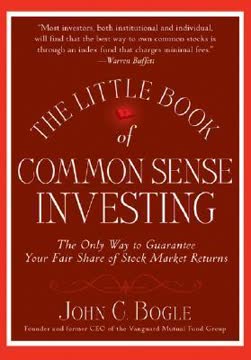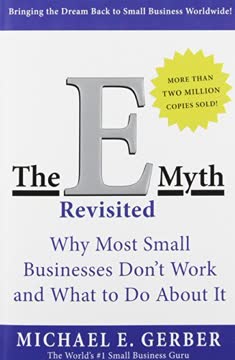Key Takeaways
1. Strategic Goal Setting is Paramount
In almost every case, the problem would be solved if they just had a meaningful goal paired with a clear strategy designed to help them reach it.
Meaningful goals. Property investment success hinges on setting specific, measurable, achievable, relevant, and time-bound (SMART) goals. Vague aspirations like "owning lots of properties" lack the precision needed to guide effective strategies. Instead, define concrete objectives, such as generating a specific monthly net profit within a defined timeframe.
Goal-driven strategies. A clear goal dictates the most suitable investment strategy. For instance, aiming for £3,000 in monthly net profit within a year necessitates a different approach than achieving the same target in ten years. The chosen strategy should align with your financial position, risk tolerance, and desired level of involvement.
Motivation and perseverance. Meaningful goals fuel motivation through challenges. Whether it's replacing your job income or securing a comfortable retirement, a compelling objective sustains commitment. Without a clear purpose, property investment can become a source of frustration rather than fulfillment.
2. Leverage Magnifies Returns, Amplifies Risks
This example shows us the power of using leverage in the form of a mortgage – which we can see by comparing this strategy to a couple of alternatives.
Mortgage power. Employing mortgages, or leverage, significantly boosts investment returns compared to all-cash purchases. Mortgages enable investors to control more assets with less capital, amplifying both potential gains and losses. A 10% property price increase yields greater profit across ten mortgaged properties than two fully owned ones.
Cashflow protection. While leverage enhances returns, it also increases financial risk. Mortgages introduce monthly payments, reducing cash flow and increasing vulnerability to market downturns. Over-leveraging can lead to financial strain if rental income fails to cover mortgage costs, especially during economic downturns.
Responsible leverage. Responsible use of leverage involves balancing potential gains with manageable risk. Prioritize cash flow to ensure properties remain profitable even during economic fluctuations. Opt for interest-only mortgages to minimize monthly payments and maximize short-term cash flow, while strategically planning for capital repayment in the long term.
3. Cash Recycling Accelerates Portfolio Growth
The strategy we’ll look at next is sometimes known as “recycling your cash”, because you reduce the amount of cash you need by taking one deposit and re-using it for multiple purchases.
Refurbishment and refinance. "Recycling cash" involves buying properties needing refurbishment, increasing their value through renovations, and then refinancing to extract equity. This strategy allows investors to reuse initial capital for subsequent purchases, accelerating portfolio growth.
Equity creation. By adding value through renovations, investors create equity out of thin air. This equity can then be accessed through refinancing, providing funds for the next investment. The key is to secure properties at a price significantly below their potential market value after refurbishment.
Risk and reward. While cash recycling reduces capital requirements, it demands more effort and carries higher risk. Success depends on accurately estimating refurbishment costs, negotiating favorable purchase prices, and executing renovations on time and within budget. Market fluctuations during the renovation period can also impact the ability to refinance at the desired valuation.
4. Capital Growth Requires Patience and Location
In many cases, the returns you get from capital growth will dwarf the rental income you receive.
Long-term strategy. Prioritizing capital growth necessitates a medium-to-long-term investment horizon. While rental income provides immediate cash flow, the real wealth-building potential lies in the appreciation of property values over time.
Strategic location. Location is paramount for capital growth. Cities, as economic hubs, generally experience stronger growth than sparsely populated areas. Prime and central areas within cities tend to appreciate faster than peripheral locations.
Yield vs. growth. Properties with high rental yields often experience slower capital growth, and vice versa. Investors must strike a balance between immediate income and long-term appreciation. Modern flats in desirable areas typically offer better growth potential than cheaper houses on the outskirts.
5. HMOs Offer High Returns, Demand Active Management
With our £250,000, we could buy nine of these (OK, we’d need to negotiate a discount of £5,000 across all nine properties to hit our budget), for a total monthly pre-tax income of fractionally under £3,000.
Cashflow focus. HMOs (Houses in Multiple Occupation) generate higher rental income compared to single-family homes. Renting out individual rooms maximizes income potential, making HMOs attractive for investors seeking rapid cash flow.
Management intensive. HMOs demand more active management. Keeping rooms occupied, addressing tenant issues, and maintaining the property require significant time and effort. Self-managing HMOs can be demanding, while hiring a managing agent reduces profit margins.
Risk concentration. Investing heavily in HMOs concentrates risk. Changes in local regulations, shifts in tenant preferences, or economic downturns can significantly impact rental income. Diversifying property types and locations mitigates these risks.
6. Trading Demands Expertise, Delivers Quick Profits
The trading model is pretty simple, but that doesn’t necessarily make it easy.
Rapid profits. Property trading, or flipping, involves buying, refurbishing, and quickly selling properties for profit. This strategy offers the potential for rapid income generation, allowing investors to replace their job income within a short timeframe.
Expertise required. Successful trading demands expertise in identifying opportunities, arranging finance, accurately estimating costs, and managing renovations. Effective marketing and sales skills are crucial for achieving desired sale prices within the desired timeframe.
High effort, high risk. Trading requires significant effort and carries inherent risks. Delays, cost overruns, or inability to sell at the target price can erode profits. Starting with smaller projects while maintaining a steady income source mitigates financial vulnerability.
7. Mortgage Brokers are Invaluable Allies
By having a broker on your team, you’ll also have someone to sense-check any potential investments before you go too far with them.
Navigating complexity. The mortgage market is complex, with numerous lenders and products. A skilled mortgage broker simplifies the process by identifying suitable options based on individual circumstances and property characteristics.
Access to the market. Brokers have access to a wider range of lenders, including those not directly accessible to the public. This ensures investors can secure the most competitive rates and terms.
Expert guidance. A good broker provides expert advice, helps navigate complex lending criteria, and keeps applications on track. Their experience and relationships can prove invaluable when unexpected issues arise during the mortgage process.
8. Location Fundamentals Drive Investment Success
The best investment areas are underpinned by solid fundamentals: jobs, schools, shops, leisure facilities and transport links.
Essential infrastructure. Successful investment locations possess strong fundamentals, including ample job opportunities, quality schools, convenient shopping, diverse leisure options, and reliable transport links. These factors attract residents and drive rental demand.
Avoiding pitfalls. Rural locations lacking employment and transport options typically underperform. Areas with high prestige and inflated property values may offer poor returns despite strong fundamentals.
In-depth research. Thoroughly research potential investment areas to understand their demographics, price norms, and rental yields. Utilize online resources, local message boards, and on-site visits to gain comprehensive insights.
9. Due Diligence Mitigates Risks
There’s always a reason why a property has ended up at auction instead of going through the normal selling channels. Before you bid, you need to find out what that reason is.
Thorough investigation. Before committing to any property purchase, conduct thorough due diligence to identify potential risks and hidden costs. This includes assessing structural integrity, reviewing legal documents, and understanding local market conditions.
Professional expertise. Engage qualified professionals, such as surveyors and solicitors, to provide expert assessments and guidance. Their expertise can help uncover potential issues that may not be apparent to the untrained eye.
Informed decisions. Base investment decisions on comprehensive information rather than emotional impulses. Avoid rushing into deals without fully understanding the potential risks and rewards.
10. Tax Planning Maximizes Profitability
The time you spend structuring your investments to be as tax-efficient as possible at the beginning could add up to tens of thousands of pounds over your investing lifetime.
Tax-efficient strategies. Property investment income is subject to various taxes, including income tax and capital gains tax. Structuring investments to minimize tax liabilities can significantly enhance long-term profitability.
Professional advice. Seek expert advice from a qualified accountant to develop a tax-efficient investment strategy. An accountant can help navigate complex tax regulations and identify opportunities to minimize tax obligations.
Ongoing optimization. Regularly review your tax strategy to adapt to changing regulations and personal circumstances. Proactive tax planning can help maximize returns and build long-term wealth.
11. Property Cycle Awareness is Crucial
When property prices double, they don’t just drift upwards in a nice predictable way. The majority of that growth happens in just a few years, and is immediately followed by some of the gains being rapidly lost.
Market timing. Understanding the property cycle is essential for maximizing returns. Property prices fluctuate over time, with periods of rapid growth followed by periods of stagnation or decline.
Strategic buying and selling. Time your buying and selling decisions to capitalize on market trends. Buy during downturns when prices are low and sell during peaks when prices are high.
Long-term perspective. While market timing can enhance returns, it's important to maintain a long-term perspective. Avoid making impulsive decisions based on short-term market fluctuations.
Last updated:
FAQ
What’s "The Complete Guide to Property Investment" by Rob Dix about?
- Comprehensive UK Buy-to-Let Guide: The book is a step-by-step manual for UK-based property investors, covering everything from setting goals to building a long-term portfolio.
- Strategic and Practical Focus: It combines big-picture strategy (like choosing the right investment approach) with detailed, actionable advice on every stage of the property investment process.
- For Beginners and Experienced Investors: Rob Dix aims to help both newcomers and those with some experience, providing models, calculations, and real-world examples.
- Adapting to a Changing Market: The book addresses recent changes in tax, regulation, and market conditions, showing how to survive and thrive as a modern property investor.
Why should I read "The Complete Guide to Property Investment" by Rob Dix?
- Realistic, Actionable Advice: Rob Dix offers practical steps, not just theory, making it easier to take action and avoid common mistakes.
- Covers the Full Investment Journey: The book goes beyond buying your first property, guiding you through portfolio growth, management, and exit strategies.
- UK-Specific Insights: It’s tailored to the UK market, including up-to-date information on tax, finance, and legal issues.
- Focus on Goals and Strategy: The book emphasizes setting meaningful goals and choosing the right strategy for your circumstances, which is often overlooked in other guides.
What are the key takeaways from "The Complete Guide to Property Investment"?
- Set Clear, Measurable Goals: Success starts with specific, time-bound, and meaningful objectives, not vague ambitions.
- Choose the Right Strategy: There’s no one-size-fits-all approach—Dix outlines five main strategies, each suited to different resources and goals.
- Know Your Numbers: Understanding yield, ROI, and cashflow is essential for making sound investment decisions.
- Adapt to Change: The property market, tax laws, and regulations evolve—successful investors stay informed and flexible.
- Long-Term Thinking Wins: Building a sustainable, resilient portfolio is more important than chasing quick wins.
What are the five main property investment strategies in "The Complete Guide to Property Investment" by Rob Dix?
- Save and Buy Regularly: Save hard, buy one property every 18 months, and let rental income compound over time for long-term wealth.
- Recycle Your Cash: Buy, refurbish, and refinance properties to reuse your initial capital and accelerate portfolio growth.
- Capital Growth Focus: Invest a lump sum in properties with strong growth potential, then wait for appreciation and consider selling or refinancing.
- High-Yield, Fast Income: Use cash to buy HMOs or multi-lets for immediate, higher rental income, suitable for those wanting to replace their wage quickly.
- Flipping/Trading: Buy, refurbish, and sell properties for profit, using the proceeds to fund further investments or as a full-time business.
How does Rob Dix recommend setting goals for property investment?
- Be Specific and Measurable: Goals should have clear numbers (e.g., “£3,000 monthly net profit”) so you know when you’ve achieved them.
- Set a Timeframe: Decide when you want to reach your goal, as this affects your strategy and risk tolerance.
- Make It Meaningful: Choose goals that genuinely motivate you, such as financial independence or early retirement, not just arbitrary property counts.
- Use Tools and Resources: Dix provides a free goal-setting spreadsheet and video walkthrough as part of the book’s extras.
What are the key calculations and metrics explained in "The Complete Guide to Property Investment"?
- Gross Yield: Annual rental income divided by the total acquisition cost (including refurbishments), used for quick comparisons.
- Net Yield: Annual rental profit (after expenses) divided by acquisition cost, giving a more accurate picture of returns.
- Return on Investment (ROI): Annual profit divided by the cash you put in, especially important when using mortgages.
- Stress Testing: Assessing how your investment would perform if interest rates rise or if there are void periods, to ensure resilience.
What is Rob Dix’s advice on financing property investments in the UK?
- Use Leverage Wisely: Mortgages amplify returns but also risk; ensure rental income covers all costs, even if rates rise.
- Interest-Only vs. Repayment: Dix generally prefers interest-only mortgages for flexibility and higher cashflow, with the option to repay capital later.
- Consider Your Circumstances: Lenders look at property value, rental income, and your personal situation (income, experience, etc.).
- Work with a Good Broker: A whole-of-market, buy-to-let specialist broker can save time, money, and help navigate complex criteria.
How does Rob Dix suggest choosing where and what to buy for property investment?
- Fundamentals First: Focus on areas with strong employment, transport links, schools, and amenities—these underpin long-term demand.
- Local vs. Remote: Investing near home is convenient, but don’t rule out other UK regions if they offer better returns or fit your strategy.
- Research Process: Use online tools (Rightmove, Zoopla, Home.co.uk) and local knowledge to compare prices, rents, and yields at a granular level.
- Property Type: Both houses and flats can work; the key is matching the property to your target market and investment goals.
What is Rob Dix’s process for assessing and negotiating property deals?
- Determine Market Value: Use recent, nearby sold prices of similar properties (comparables) to establish true value, not just asking prices.
- Calculate Your Maximum Price: Factor in your required ROI, all costs, and your strategy to set a ceiling for your offer.
- Be Conservative: Build in contingencies for refurb costs, voids, and unexpected expenses to avoid overpaying.
- Negotiate Effectively: Start with a low offer, be prepared to walk away, and use speed and certainty as bargaining chips.
What are the main risks in property investment, and how does "The Complete Guide to Property Investment" advise managing them?
- Market Downturns: Understand the property cycle; don’t over-leverage, and ensure your portfolio can survive recessions without forced sales.
- Cashflow Shortfalls: Always stress-test your numbers, maintain cash reserves, and prioritize properties with strong yields.
- Legal and Regulatory Compliance: Stay up-to-date with landlord obligations, tax changes, and safety regulations to avoid costly mistakes.
- Management Challenges: Decide whether to self-manage or use agents, and have systems in place for tenant selection, rent collection, and maintenance.
How does Rob Dix explain the property cycle and its importance for investors?
- Four Stages: The cycle includes recovery, explosive growth, winner’s curse (peak), and recession, typically lasting around 18 years.
- Timing Matters: Recognizing where you are in the cycle helps you avoid buying at the peak or selling at the bottom.
- Media vs. Reality: Don’t rely on headlines—look for real-world signals like lending criteria, building activity, and investor sentiment.
- Strategic Moves: Use the cycle to plan acquisitions, sales, and refinancing, and to prepare for downturns with cash reserves and conservative leverage.
What are the recommended exit strategies in "The Complete Guide to Property Investment" by Rob Dix?
- Hold Forever: Continue to collect rental income, even into retirement, using long-term buy-to-let mortgages if needed.
- Sell to Repay Debt: Sell part of your portfolio to pay off mortgages on the rest, creating a debt-free income stream.
- Liquidate Entirely: Sell all properties and invest the proceeds elsewhere for diversification or simplicity, considering tax implications.
- Restructure for Retirement: Adjust your portfolio mix (e.g., sell low-yield or high-maintenance properties) to match your income and risk needs in later life.
Review Summary
The Complete Guide to Property Investment receives overwhelmingly positive reviews, with readers praising its comprehensive coverage of UK property investing. Many find it accessible, informative, and engaging, even for beginners. Readers appreciate the practical advice, real-world examples, and detailed explanations of various strategies. The book is lauded for its thorough coverage of topics like financing, taxes, and property management. While some note its UK-specific focus, many still find value in the general principles. Overall, readers recommend it as an essential resource for anyone interested in property investment.
Similar Books







Download PDF
Download EPUB
.epub digital book format is ideal for reading ebooks on phones, tablets, and e-readers.




